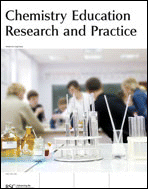Conceptual versus algorithmic learning in high school chemistry: the case of basic quantum chemical concepts. Part 2. Students’ common errors, misconceptions and difficulties in understanding
Abstract
Part 2 of the findings are presented of a quantitative study (n = 125) on basic quantum chemical concepts taught at twelfth grade (age 17-18 years) in Greece. A paper-and-pencil test of fourteen questions was used that were of two kinds: five questions that tested recall of knowledge or application of algorithmic procedures (type-A questions); plus nine questions that required conceptual understanding and/or critical thinking (type-C questions). As a rule, performance in type-A questions was relatively high while in the type-C questions it was much lower. Unacceptable performance in type-A questions was mainly caused by the application of a wrong algorithm or by partial answers. Analysis of the individual type-C questions led to the identification of common errors, misconceptions and difficulties in understanding. The Bohr model and the language of the old quantum theory featured prominently in the answers of many students, while other students were holding hybrid models, mixing the planetary with the quantum-mechanical model. Finally, suggestions for improved instruction and curricula are made.

 Please wait while we load your content...
Please wait while we load your content...